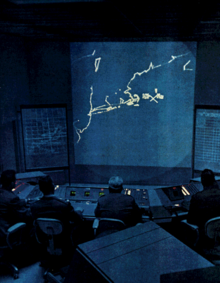Semi-Automatic Ground Environment

Semi-Automatic Ground Environment ( SAGE ) was the first computerized air defense system of the North American space defense command NORAD . It was tested for the first time in 1952. SAGE was intended to track down, track and intercept Soviet long-range bombers . By the time it was finally fully operational in 1963, the threat posed by bombers had already been eclipsed by that of ICBMs . However, SAGE was completely unsuitable for this. Nevertheless, the project had a significant influence on the development of computer systems in the area of real-time processing of information and networking via modems .
SAGE was headed by Robert Everett, one of the builders of the Whirlwind , who in this role was the technical director of Miter Corporation . The Radio Corporation of America initially received the contract to build a tube computer based on the Whirlwind project developed by the Massachusetts Institute of Technology . However, it later went to IBM , which began building the computer in 1958.
The AN / FSQ-7 (Whirlwind II) tube calculator consisted of 55,000 electron tubes and had a magnetic core memory . With a weight of 275 tons, it covered an area of over 2000 m² and had a power consumption of up to 3 MW . This made the supercomputer larger in terms of its spatial dimensions than any other computer system. No such space-consuming system has been built up to the present. It collected data from the connected observation stations in real time and enabled the operators to easily select the targets to be combated. To this end, the system were also the status of interceptors of all airports of the area and the Bomarc - or Nike Hercules - aircraft missiles delivered.
Since the operators were not computer specialists, but simple soldiers, a complex human-computer interface was developed for the first time. Screen systems for text and graphic representations and the light pen as an input device for graphic data were created. As soon as a target seemed interesting and the operator decided to intercept it, messages were automatically sent via teletype to the responsible local authorities.
The SAGE air defense was in operation until 1979 and was then replaced by newer systems, later also airborne surveillance systems ( AWACS ). The last computer was turned off in 1983 and is now in the Boston Computer Museum . The US cost the SAGE system around eight billion US dollars.
literature
- John F. Jacobs, The SAGE Air Defense System: A Personal History (MITER Corporation, 1986)
- RG Enticknap and EF Schuster, SAGE Data System Considerations , AIEE Transactions vol 77, pt I, 1958 (January 1959 section), pp 824-832.
- Robert R. Everett (editor), Special Issue: SAGE (Semi-Automatic Ground Environment) , Annals of the History of Computing 5: 4 (1983).
- Paul N. Edwards, The Closed World: Computers and the Politics of Discourse in Cold War America (Cambridge, MA: MIT Press, 1996) [1] , esp. Chapter 3 .
- Kent C. Redmond, Thomas M. Smith: From Whirlwind to MITER: The R&D Story of The SAGE Air Defense Computer . MIT Press, Cambridge 2000. ISBN 0-262-18201-7
- Thomas P. Hughes , Rescuing Prometheus: Four Monumental Projects That Changed the Modern World , esp. Chapter 2. Pantheon, 1998. ISBN 0-679-41151-8
- Bernd Ulmann , AN / FSQ-7: the computer that shaped the Cold War , Oldenbourg Wissenschaftsverlag, 2014. ISBN 978-3-486-72766-1
Web links
- Web archive: About the SAGE and its control of the F-106 interceptor ( Memento from August 7, 2012 in the Internet Archive )
- SAGE Air Defense youtube.com, February 3, 2017
- On Guard: The Story of SAGE (1956) IBM Corporation, Military Products Division
- In Your Defense - Cold War Computing: The SAGE System, Computer Museum on YouTube

